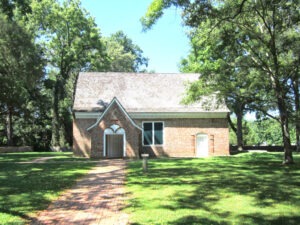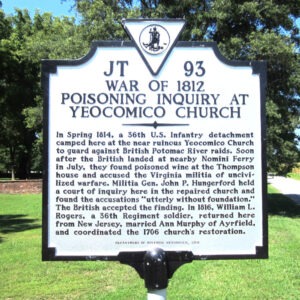In Westmoreland County, tucked between Kinsale and Coles Point, stands

Yeocomico Episcopal Church, a small building with a rich history. The original church building was believed to have been built around 1655, but it was later reconstructed in 1706. The church even carries ties to many of Virginia’s prominent figures. Both George Washington and Richard Henry Lee were baptized there.
In the midst of America’s split with the English Church, Yeocomico was abandoned and sat vacant for many years. At one point, it was occupied by troops during the Civil War. Later, it was utilized as a school house.
During the War of 1812, the Northern Neck became an active battleground and many of the exchanges between British and American troops would wreak havoc in the area and leave lasting effects that remain to this day. In 1814, soldiers took up residence at the church—during this time, they destroyed and misused many artifacts from the church. The baptismal font in particular was removed and used for drinking spirits. Around this time, British and American troops clashed heavily in the area and destroyed many nearby homes and plantations. At one point, British officers claimed that American soldiers had purposely planted poisoned wine for them to find. The British argued that the Americans were guilty of uncivilized warfare and pressed for an official inquiry into the matter.
A historical marker commemorating the incident has been placed near the church. It reads as follows:
In Spring 1814, a 36th U.S. Infantry detachment camped here at the near ruinous

Yeocomico Church to guard against British Potomac River raids. Soon after the British landed at nearby Nomini Ferry in July, they found poisoned wine at the Thompson house and accused the Virginia militia of uncivilized warfare. Militia Gen. John P. Hungerford held a court of inquiry here in the repaired church and found the accusations “utterly without foundation.” The British accepted the finding. In 1816, William L. Rogers, a 36th Regiment soldier, returned here from New Jersey, married Ann Murphy of Ayrfield, and coordinated the 1706 church’s restoration.
The inquiry was dismissed—and eventually troops dissipated and battle ended.
William L. Rogers, a New Jersey soldier who had found refuge in the church, grew to admire the building and would later return to aid in its restoration. The church has undergone multiple renovations between the 1820s and mid 2000s. Today, the little church is well kept and many of its unique features and artifacts have been restored to their former glory.
Information sourced from the Northern Neck Historical Society and the Historical Marker Database


